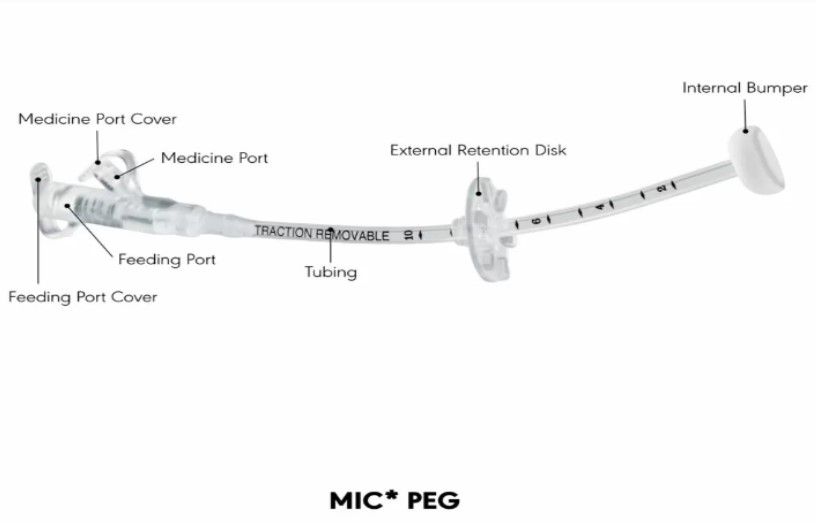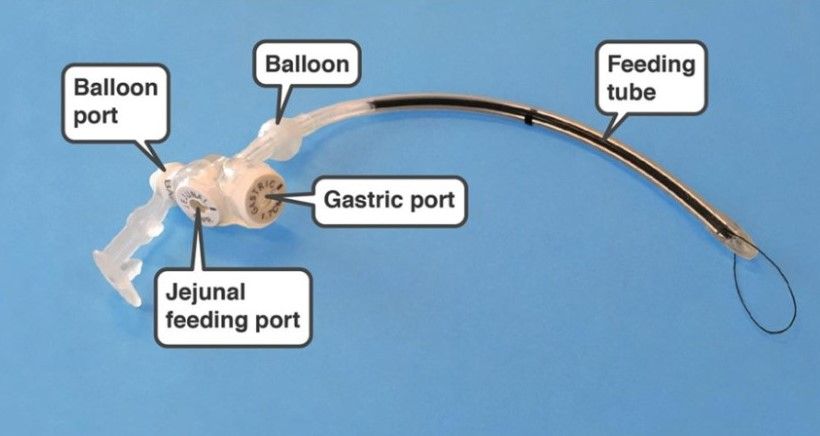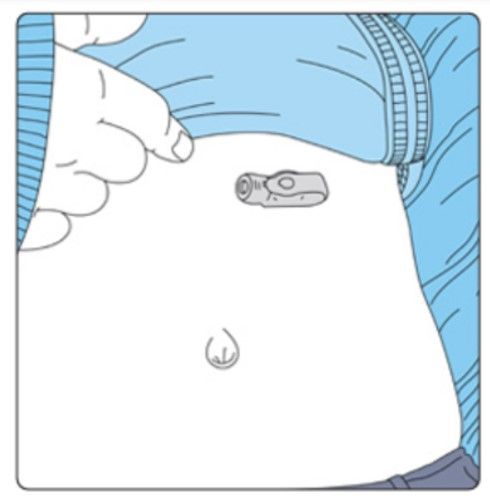Percutaneous endoscopic gastrostomy (PEG) is a procedure where a flexible feeding tube (commonly known as a PEG tube) is inserted through the abdominal wall and into the stomach. This may be placed under surgical or radiological guidance. Another procedure is usually needed to convert these tubes to a low-profile tube about 8 weeks later. A low-profile gastrostomy tube is a type of gastrotomy tube that is placed into the stomach through the abdominal wall and lies close to the belly. It is less bulky and more discreet.

Care Instructions
- Avoid soaking in standing water (tub baths, Jacuzzis, pools, lake, or ocean).
- You may shower the day after the tube was placed.
- Clean under the external retention disk daily with soap and water. Pat under the disc dry and apply new split gauze dressing under the disc. Cleaning the tube site daily will help prevent infection and skin irritation.
- A small amount of clear tan drainage from the tube exit site can be normal.
- Make sure the disc on the tube fits slightly snug against the skin so that the tube does not move in or out of the body easily.
- Flush your tube with water twice a day to prevent the tube from clogging (or follow recommendations from your provider if given).
Giving Feedings and Medications
- Follow-up with your provider for instructions on tube feedings and medication administration.
- ONLY use specific foods designed for use with your G/GJ tube (Unless otherwise discussed with your provider).
- Flush the tube at least twice daily with water or follow dietician's instructions if given.
- Flush the tube before and after administrating medications and feedings.
- Note: Most jejunal (J port) feedings are given by a continuous method. Continuous feeding is given with a pump over a period, usually 12 to 24 hours based upon your specific situation.

Low-Profile GJ Tube

Low-Profile G-Tube
Follow Up
- We recommend changing your feeding tube every 3 months. GJ tube changes ALWAYS are exchanged in Radiology. Please contact Radiology to arrange a GJ tube exchange appointment. You will need to schedule an appointment about 8-12 weeks after placement to convert the PEG to a low-profile G-Tube with Radiology or another trained provider. After this, low profile G-Tube changes can be done every 2-3 months at home.
- G/GJ tubes CANNOT be removed until 6 weeks after date of tube placement.
- T-fasteners/Buttons (sutures) should be removed 7-10 days after tube placement. This may have been done while you were still at the hospital. It can also be completed in youra outpatient clinic or care facility. Please contact Surgery/Radiology for T- fastener questions, concerns or for instructions for removal.
When To Seek Medical Evaluation
- Fever greater than 101°F (38.3C).
- Purulent (yellow/green/foul smelling) drainage from tube exit site.
- Significant or worsening abdominal pain.
- Skin that is hot to the touch or significantly reddened at the tube exit site.
- Bleeding at tube exit site.
- Tube falls out or felt to be out of position.
- Unable to flush tube.
- Significant leakage around tube site (tube feeding, medications, or drainage).
- Severe pain at tube exit site.
**NOTE: Please follow specific instructions from the Surgery/Radiology teams as well since these are meant to be general post placement care guidelines.
This information is for educational purposes only. It is not intended to replace the advice of your health care providers. If you have any questions, talk with your doctor or others on your health care team. If you are a Gillette patient with urgent questions or concerns, please contact Telehealth Nursing at 651-229-3890.
